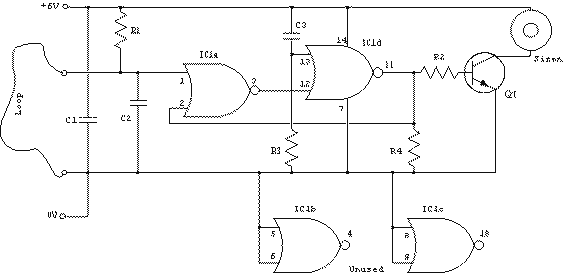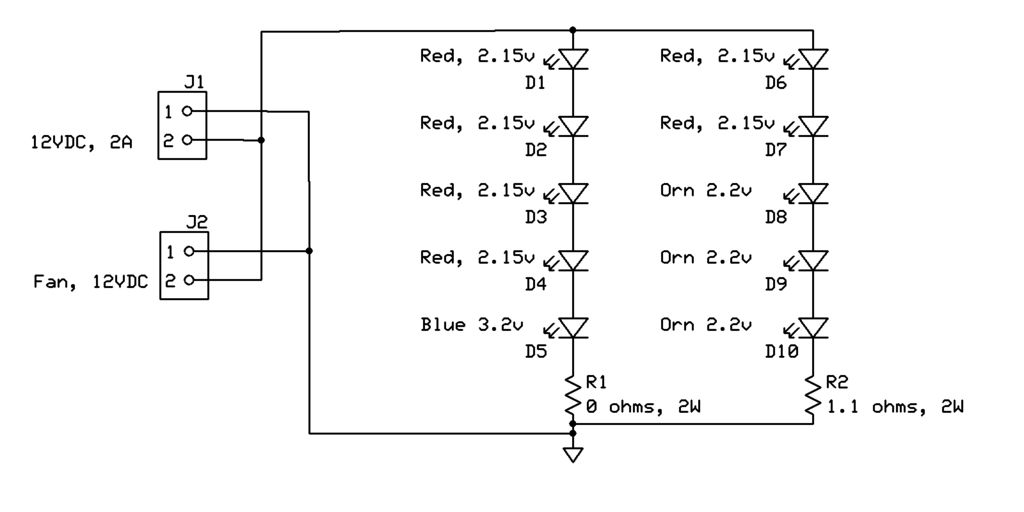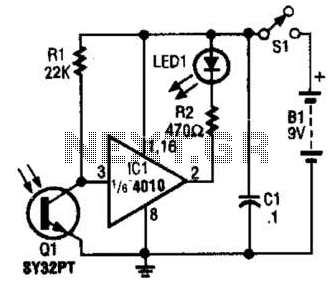
Light emitting diode circuit of the temperature control

The circuit consists of two light-emitting diodes (D1 and D2) whose operation is controlled by the ambient temperature. A temperature sensor, the LM35, generates an output of 10 mV for each degree of temperature increase. A reference potentiometer, R2, is utilized to set the output voltage of the LM35, with the non-inverting input connected to the inverting input of the operational amplifier CA3130. If the reference voltage is set to 0.8 V, the output voltage from the LM35 reaches 0.8 V when the temperature is 80 degrees Celsius, causing the output of IC3 to reach positive saturation. This activates transistors Q1 and LED D1, while LED D2 remains off due to the connection of the base of Q2 to the collector of Q1. When the temperature drops below 80 degrees Celsius, the opposite occurs. IC1 provides a stable 5 V DC supply from a 9 V DC input. If a 5 V DC power supply is available, it can be used directly. Precautions for the schematic include proper assembly of the circuit board and installation of the IC3 holder. The temperature trip point can be adjusted using POTR2. The transistors Q1 and Q2 must be common NPN types.
The circuit operates as a temperature-based LED indicator system, leveraging the characteristics of the LM35 temperature sensor and the CA3130 operational amplifier. The LM35 outputs a voltage proportional to the temperature, allowing for precise temperature monitoring. The choice of a reference voltage of 0.8 V is critical, as it establishes the threshold temperature at which the circuit will activate. When the LM35 output reaches this reference, the operational amplifier switches its output high, indicating that the temperature has exceeded the set point.
Transistors Q1 and Q2 are configured in a manner that ensures only one LED is illuminated at a time, providing a clear visual indication of temperature status. The circuit's design allows for easy adjustment of the trip point using the potentiometer R2, enabling flexibility in temperature settings based on specific requirements. The use of a stable power supply, provided by IC1, ensures reliable operation of the entire circuit, while the assembly precautions emphasize the importance of proper circuit construction and component placement to avoid malfunctions.
Overall, this circuit is suitable for applications where visual temperature monitoring is necessary, such as in temperature-sensitive environments or for educational purposes in demonstrating temperature sensing and control principles.Explanation The circuit is nothing more than two light emitting diodes (D1 and D2), its position is controlled by the temperature of the surrounding environment. Here the tempe rature sensor known as the IC LM35. LM35 increase the output of 10mV per degree of temperature rise. You can use the desired reference potentiometer R2 to the output voltage of the LM35 given the non-inverting input is connected to the same operational amplifier inverting input of the operational amplifier CA3130.The. If the reference voltage is 0.8V, then the non-inverting input terminal (LM35 output) voltage becomes 0.8V, when the temperature is 80 degrees Celsius.
Then the output of IC3 to positive saturation. This makes the transistors Q1 and D1 LED lights glow. Since the basis of the second quarter, Q1 is connected to the collector of the second quarter will close LED D2 remains closed. When the temperature is below 80 degrees Celsius reverse happens.IC1, produce a stable 5V DC working available9V DC supply voltage.
If you already have a 5V DC power supply, then you can use it directly. Schematic Precautions The circuit board assembly in Verona. IC3 holder must be installed. You can adjust the settings POTR2 temperature trip point. Type no Q1 and Q2 is critical. Any common NPN transistors will do it.
The circuit operates as a temperature-based LED indicator system, leveraging the characteristics of the LM35 temperature sensor and the CA3130 operational amplifier. The LM35 outputs a voltage proportional to the temperature, allowing for precise temperature monitoring. The choice of a reference voltage of 0.8 V is critical, as it establishes the threshold temperature at which the circuit will activate. When the LM35 output reaches this reference, the operational amplifier switches its output high, indicating that the temperature has exceeded the set point.
Transistors Q1 and Q2 are configured in a manner that ensures only one LED is illuminated at a time, providing a clear visual indication of temperature status. The circuit's design allows for easy adjustment of the trip point using the potentiometer R2, enabling flexibility in temperature settings based on specific requirements. The use of a stable power supply, provided by IC1, ensures reliable operation of the entire circuit, while the assembly precautions emphasize the importance of proper circuit construction and component placement to avoid malfunctions.
Overall, this circuit is suitable for applications where visual temperature monitoring is necessary, such as in temperature-sensitive environments or for educational purposes in demonstrating temperature sensing and control principles.Explanation The circuit is nothing more than two light emitting diodes (D1 and D2), its position is controlled by the temperature of the surrounding environment. Here the tempe rature sensor known as the IC LM35. LM35 increase the output of 10mV per degree of temperature rise. You can use the desired reference potentiometer R2 to the output voltage of the LM35 given the non-inverting input is connected to the same operational amplifier inverting input of the operational amplifier CA3130.The. If the reference voltage is 0.8V, then the non-inverting input terminal (LM35 output) voltage becomes 0.8V, when the temperature is 80 degrees Celsius.
Then the output of IC3 to positive saturation. This makes the transistors Q1 and D1 LED lights glow. Since the basis of the second quarter, Q1 is connected to the collector of the second quarter will close LED D2 remains closed. When the temperature is below 80 degrees Celsius reverse happens.IC1, produce a stable 5V DC working available9V DC supply voltage.
If you already have a 5V DC power supply, then you can use it directly. Schematic Precautions The circuit board assembly in Verona. IC3 holder must be installed. You can adjust the settings POTR2 temperature trip point. Type no Q1 and Q2 is critical. Any common NPN transistors will do it.





